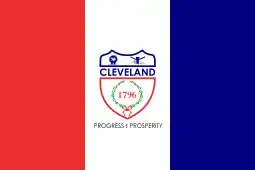Flag of Cleveland
The municipal flag of Cleveland serves as the representative banner of the city of Cleveland, Ohio, United States. The flag was designed by local art school graduate Susan Hepburn, and was officially adopted as the municipal banner by Cleveland City Council on October 21, 1895,[1] with the ordinance on the flag adopted on February 24, 1896.[3]
 | |
| Use | Civil flag |
|---|---|
| Proportion | 2:3 |
| Adopted | October 21, 1895[1] |
| Design | A vertical triband of red (left), white (middle), and blue (right), with a shield in the center with the name "Cleveland" breaking through near the top. The bottom portion of the shield is outlined in red and consists of the year "1796" surrounded by a laurel wreath. The top portion is outlined in blue with symbols representing the city's association with industry and maritime interests. At the bottom is the municipal motto "Progress & Prosperity". |
| Designed by | Susan Hepburn[2] |
History
The idea for a Cleveland flag was first proposed by New York journalist Julian Ralph in an interview at the Hollenden Hotel with Plain Dealer reporter William Stokely Lloydon on April 24, 1895.[1] Elaborating on the idea, Ralph stated:
Let us make our citizens proud of the virtues of our cities. Let us make them jealous of the political reputation of our cities. Let us cause them to be intent upon good government and upon maintaining it. One way to do this is to fly the city flag over their heads.[1]
The proposal was positively received by both city leaders and the public, and it sparked a contest to design a new flag in advance of the city's centenary sponsored by The Plain Dealer. The selection committee was chaired by Ohio artist Archibald Willard. More than two dozen entries were submitted, including proposals with municipal seals featuring the Columbia-like goddess of liberty in classical Greek dress accompanied by Latin mottos.[1]
The contest winner was Susan Hepburn, an 18-year-old art school graduate and a descendant of settlers of the Connecticut Western Reserve.[4] The selection committee praised her design for its "power and simplicity."[1] Robert Beach, the Plain Dealer reporter who delivered the prize to Hepburn, later became her husband.[2]
On October 21, the flag was approved by Cleveland City Council. The city's flag committee later resolved to add a municipal motto to the design on October 25. Although the Latin motto "Major et Melior" (Greater and Better) was originally favored by city leaders, Mayor Robert McKisson instead advocated the English motto "Unity and Progress", which eventually became "Progress and Prosperity".[1]
Some Clevelanders opposed the adoption of any municipal flag, fearing that it would compete with the flag of the United States. Despite these objections, an ordinance was put in place on the banner on February 24, 1896, the year in which Cleveland celebrated its centennial.[5] The adoption of the Cleveland flag inspired Cincinnati to adopt a flag of its own.[1]
Design and symbolism
Cleveland's municipal charter, adopted in 1913, describes the flag as follows:
The Municipal emblem of the City shall be a banner of the following description and design: the banner shall consist of three (3) vertical stripes, of equal width, in color red, white and blue respectively, the red being nearest the standard and the white in the center. The middle stripe shall bear the American shield with the word ‘Cleveland,’ in blue, across its center, and the figures ‘1796’ in red, at its base, encircled by a laurel wreath. The outline of the lower half of the shield shall be in red and of the upper in blue. In the upper left-hand corner of the shield shall stand an anvil, hammer and wheel, and in the upper right-hand corner an anchor, windlass and oars. Under the shield, in black letters, shall be placed the words 'Progress and Prosperity.'[1]
Both the colors and the use of the American shield represent patriotism. 1796 is the year in which Cleveland was founded by General Moses Cleaveland. The anvil, hammer, and wheel represent industry and manufacturing, while the anchor, windlass (alternatively, capstan), and oars represent the city's status as a major port on the Great Lakes. The municipal motto, "Progress and Prosperity", refers to the rapid growth that Cleveland experienced in the period of the flag's adoption.[1]
References
Citations
- "Municipal Symbols". The Encyclopedia of Cleveland History. Case Western Reserve University. October 3, 2022. Retrieved May 19, 2023.
- Breig, James (July 14, 2016). "City flag sparked six-decade romance". Gettysburg Flag Works. Retrieved August 1, 2023.
- Rose, William Ganson (1990). Cleveland: The Making of a City. Kent, OH: Kent State University Press. pp. 569–570. ISBN 978-0873384285.
- Rose 1990, pp. 566–567.
- Rose 1990, p. 570.